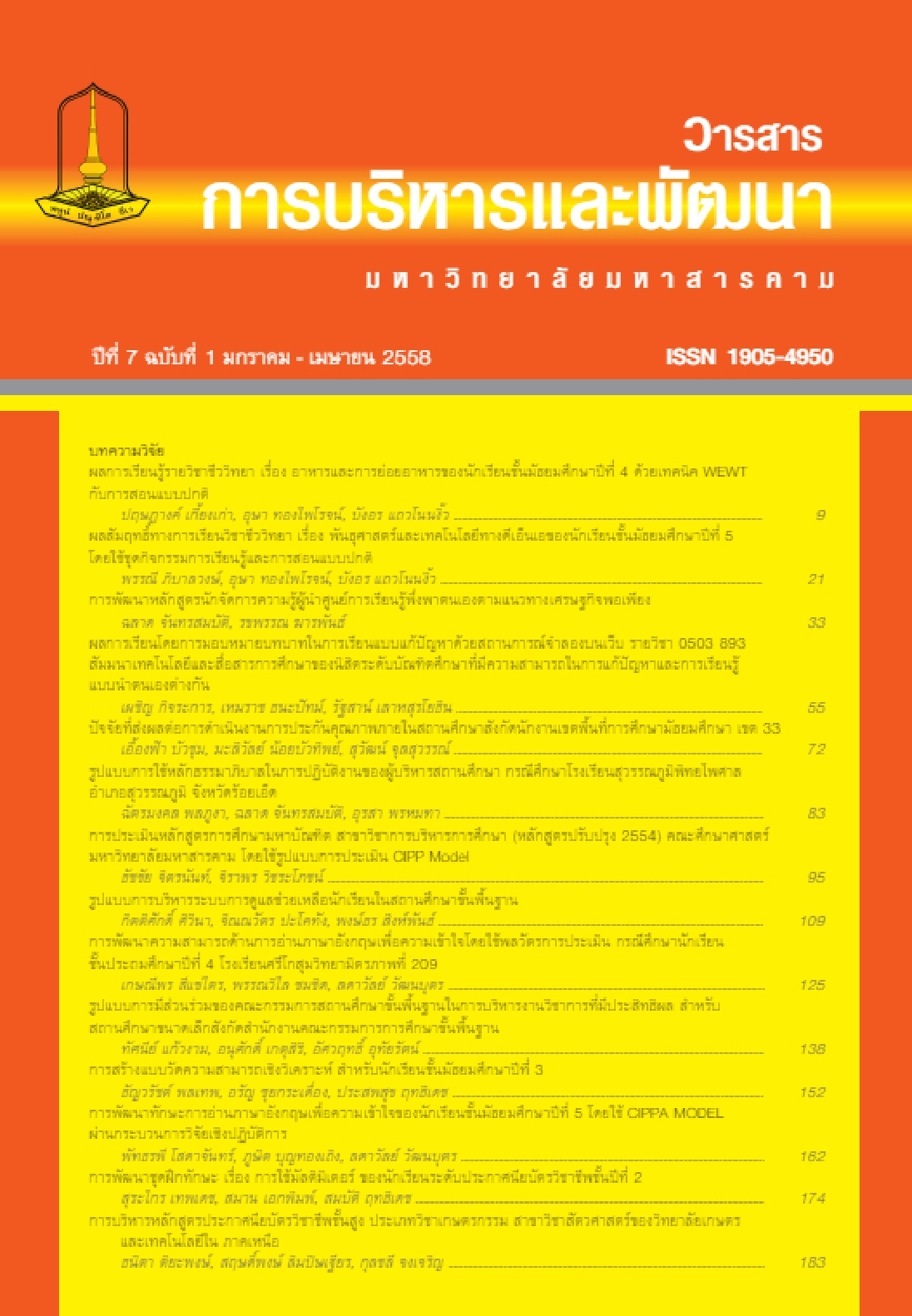Biology learning outcomes on food and digestion, Matthayomsuksa 4 students using the WEWT and the traditional approach
Main Article Content
Abstract
The purpose of this study were to 1) develop lesson plans for organization of learning with WEWT technique and the traditional approach on a topic of food and digestion with a required efficiency 75/75 2) find out effectiveness indices of the lesson plans for organization of learning with WEWT technique and the traditional approach on the topic of food and digestion 3) compare learning achievement of Matthayomsuksa 4 students between pre-test and post-test by using The WEWT and the traditional approach 4) study the satisfaction of student learning using WEWT technique. The sample for this study consist of Matthayomsuksa 4 Students in the 2nd semester of academic year of 2013, attending kutchumwittayakom school. They were selected using the purposive sampling technique and randomly divided into two groups: The experimental group one which including 43 M.4/7 students learning WEWT technique,and the experimental group two which consists of 43 M.4/8 students learning the traditional approach . The tools used in this study were: 1) the lesson plans for organization learning activities with WEWT and the traditional approach, which consist of 6 lesson plans and spent 12 hours in each approach 2) a 30-item-4 –choice achievement test with discriminating power (B) ranging from 0.20-0.46 with reliability of 0.85 3) the satisfaction questionnaire. Basic statistics used for analyzing the collected data were percentage, mean and standard deviation; and the statistic used for testing hypothesis was t-test (dependent).
The results of the study were as follows:
1. The efficiencies of the lesson plans for organization of WEWT learning technique and the traditional approach for Matthayomsuksa 4 were 84.82/80.23 and 80.96/76.35 respectively.
2. The effectiveness indices of lesson plans for organization of WEWT learning technique and and the traditional approach for Matthayomsuksa 4 were 0.7125 and 0.6549 respectively
3. The students who learning by the WEWT and the traditional approach are statistically significant at the .01 level.
4. The satisfaction of Matthayom 4 students after using the WEWT Technique was at highest level ( x̅ = 4.56) In conclusion, The lesson plans of organization of learning by the WEWT and the traditional approach were appropriately efficient and effective, As a result
In conclusion, The lesson plans of organization of learning by the WEWT and the traditional approach were appropriately efficient and effective, As a result student’s learning skills and their academic achievement are higher, Science teacher could implement them to organize learning activities or in applying them to generating maximum benefits to organization of learning in the future.
Downloads
Article Details
References
Arunya Suthasinobon. (2002). Integrated academic instruction. 5(12): 20-26.
Bonchom srisaard. (2002). Preliminary research. 5th edition. Bangkok: Suweyasan.
Braham, E. (1997) “Literature and Science create an engaging combination,”Middle school journal. 29(1): 34-39.
Department. (2001). Learning by Problem. Bangkok: First Place and graphics.
Joyce, B, & Weil, M. (1996). Model of teaching. 5th ed. Boston: Allyn and Bacon.
Kaengsuk jaruansuk. (1999). Critical Thinking. 4th edition. Bangkok: Media Success.
Kamika Tubtimsai (2003). The development of training strategies for learning English vocabulary levels Secondary 3 school years Tha Maka Maka Kanchanaburi. Thesis M.A. Bangkok: Silpakorn University.
Klausmeier” H.J. (1985). Educational psychology. 5th ed. New York: Harper & Row.
Kodchakorn Tiputdee. (1999). Developing the ability to recognize words in English with patterns Teaching for a reminder for students majoring in English. Ubonratchathani: Ubonratchathani Ratjabhat.
Louan saiyod and Aungkana saiyod. (1998). Technical education research.:Department of Research and Evaluation Education: University Pathumwan.
Napattharin Paopan. (2011). The effect of learning English vocabulary by learning styles. Teaching memorizing the illustrations Based on Multiple Intelligences Theory For students in vocational schools Teerapada technology Roi Et. Thesis M.A. Mahasarakham: Mahasarakham Ratjabhat.
Pachean Kitrakarn. (2001). Indices effectiveness. Mahasarakham: Department of Communications and Technology The Faculty of Education Mahasarakham University.
Peter Hudson. (2009). “Learning to Teach Science Using English As The Medium of Instruction”. Eurasia Journal of Mathematics, Science & Technology Education, 5(2): 165-170.
Renate N.Caine and Geolffrey Caine. (1997). Education on the Edge of Possibility.
Siripat Jadsadawirod. (2003). Curriculum integration For students that year. Wat Samian 1 Bangkok. Thesis of Philosophy Study (Curriculum and Instruction) Kasatsard University.
Somnuk Pattiyatanee. (2001). Education Measurement. Karasin: Coordinate printing.
Tirsana Kammanee. (2012). Science teaching. 14th edition. Bangkok:Chulalongkorn University.
Wheatley, G. H. (1991). “Constructivism Perspective on Science and Mathematics.” Science Education 75, 1(January 1991): 9-21.


